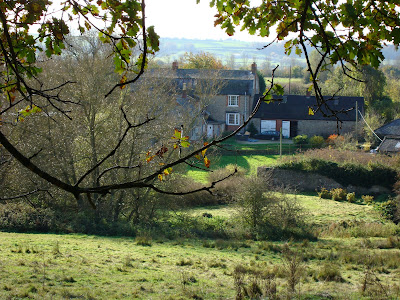Tuesday, 28 October 2008
The old railway walk (and sarsens)
These are on the bank of a slope leading up to housing development behind the old railway track. A local woman out for a walk told me that before there have always been there - before the houses there was a field and the stones were just there. So it seems that parts of old Swindon may have once been near a sarsen drift valley - perhaps where the motorway now runs. These stones would have no doubt been cleared from the route of the railway that used to run from Wootton Bassett to Marlborough via Old Town.
Thursday, 16 October 2008
Ancient Echoes
 A menhir shaped stone standing in Radnor Street Cemetery - very smooth and curved on one side. It is not hard to imagine that it may have one stood in a stone circle where the rites of life and death were enacted by our ancestors.
A menhir shaped stone standing in Radnor Street Cemetery - very smooth and curved on one side. It is not hard to imagine that it may have one stood in a stone circle where the rites of life and death were enacted by our ancestors.To people who do not know Swindon, our town compares unfavourably with the architecturally magnificent cities of Oxford to the north, Bath to the west, and Salisbury to south. Swindon has its own heritage firstly as a Wiltshire market town on a hill (Old Town) then later with the coming of Brunel's Great Western Railway as an working railway town. Following the construction of the m4 motorway, however, the town's image started to suffer - industrial and trading estates sprang up while large housing developments gobbled up the land. Still more developments continue and more green belt land is being lost. The most recent casualty is the Front Garden - the farmland that buffered the town from the motorway. Home to small herds of deer and other wild life .... all now displaced. The land surrounding Coate Water Country Park, still much coveted by developers, is not yet safe in spite of a vigorous campaign to protect it.
As I walk around this town that I have grown to love, I hear the cry of nature breaking through the cracks in the pavements. I hear its song along cycle tracks in the hawthorn and elder and in the small wooded areas that have somehow survived. I hear it in the wind whispering through the old willows by the many small streams and brooks that meander around the edges of the town.
All across the eastern side of the town there are sarsen stones seemingly scattered - though in fact thoughtfully positioned to enhance green open spaces and parkland. I have become something of a stone enthusiast and it always gives me pleasure to find new ones ..... except they are anything but new. Each new 'find' brings its own quiet stillness and ancient echo. Some have clearly been imported from the Marlborough Downs while others have something even more resonant of the distant past about them.
Thursday, 9 October 2008
Weathervane Hill (near the Ridgeway)
The Ridgeway and Waylands Smithy
A short walk along the Ridgeway towards Uffington lies the burial chamber, Waylands Smithy, hidden by a screen of tall beeches, it was used for burials over 5,500 years ago in the Neolithic period.
Taken from the small information board erected by English Heritage:
Excavations have shown that the monument you see today covers and earlier barrow. Both tombs served as a focus for ceremonies linking the living and the dead, and may also have marked the community's ownership of the surrounding land.
The first structure was built here, between 3,590 and 3,555BC - it was a stone and timber box with two split tree-trunks positioned at each end. Over the period of less than 15 years the remains of 14 people, eleven males, two females and a child were placed in the box.
By the time the chambers were examined in 1920 they had been ransacked but they still contained the remains of several people. The Ridgeway - towards Uffington
The Ridgeway - towards UffingtonSwindon is overlooked by the wonderful prehistoric landscape of the chalkland 'barrow' Marlborough Downs. The Ridgeway transverses the downs just south-east of Swindon near Barbury Castle and Chiseldon. Today I was fortunate enough to meet up with a friend for the short drive up via Bishopstone, Idstone and Ashbury - all beautiful little villages on Swindon's doorstep.
It was a sunny, windblown October afternoon; the Ridgeway, along this stretch was lined with berry bearing hawthorn, buckthorn, elder and the unusual spindle tree, all interlaced with bright-red woody nightshade. Today, I saw more red admiral butterflies than I have seen all summer - these vivid butterflies did a upward curious spinning thing which I hadn't noticed before.
This section has been extensively repaired and the deep ruts left by 4x4 vehicles that used to frequent the track have been filled in. I am happy to report that 4x4s are banned from this particular stretch of the Ridgeway.
Subscribe to:
Comments (Atom)










